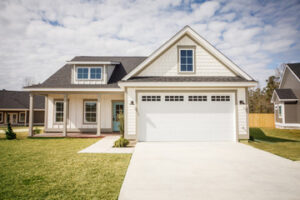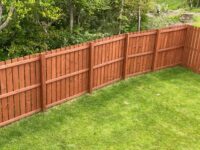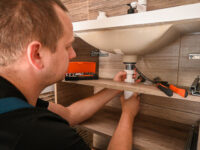Garage Door Repair – What to Do When Your Garage Door Needs Repair
Garage doors are prone to various types of damage. Some issues may be cosmetic and affect aesthetics, while others can compromise the door’s structural integrity or energy efficiency.
Some repairs require professional assistance. For example, removing springs is hazardous for do-it-yourselfers due to the high tension involved. Other problems require routine maintenance to avoid further damage and ensure safe operation. Contact Garage Door Repair Buckeye for professional help.
Garage doors are a large component of your home’s exterior and prone to wear and tear. Even if your door is made from high-quality materials like steel or timber, it’s still vulnerable to damage from weather and regular use. When your garage door sustains damage, it’s important to address it as soon as possible to avoid further problems. Whether it’s a cracked panel or a bent section, your door will need to be either repaired or replaced.
A garage door is a complex system, and the panels work together to lift and lower it safely. A damaged panel can throw off the balance of your entire door and create problems down the line. Dented or smashed panels might seem minor, but they can cause other parts to wear down prematurely. This can lead to expensive repairs and even replacement of the entire door.
Keeping your garage door in good condition requires routine inspections and maintenance. These preventative measures can identify potential issues before they turn into costly repairs. During these inspections, you should look for signs of wear and damage on your door’s panels. These include dents, scratches, and scuff marks. These cosmetic issues can often be repaired with sanding and wood putty or repainting.
While you can do some of these touch-ups yourself, major damage will require the expertise of a professional. Substantial damage can affect the functionality of specific components such as sensors and torsion springs, so it’s best to have this damage addressed by a professional.
If your garage door is a newer model, you may be able to replace the damaged sections without needing to replace the entire door. Older models are more likely to need the whole door replaced if they have substantial damage or are showing signs of wear and tear.
Broken Cables
Garage doors are heavy, complicated mechanisms that must be operated safely. They are constructed of many parts and require regular maintenance to keep them in good working order. The cable system is a key component to the operation of your door. It helps move the door up and down over a series of pulleys and winding on the cable drum or spool.
The cables are under constant stress from daily use and should be inspected regularly for signs of wear or fraying. If the cables are not in good condition, they can become disconnected from the pulleys and fall off the drum or spool. This can create a dangerous situation, and should be immediately addressed by a professional.
When a cable snaps, it creates a significant amount of tension in the springs and can cause further damage to the overhead door. It may also make the garage door unusable and potentially unsafe for anyone to open or close it. Broken cables are a common problem and can be caused by a number of factors, including general wear and tear, lack of maintenance and improper installation.
You can inspect your garage door’s cable system and look for signs of fraying or kinking, but you should not attempt to repair it yourself. The cable is under a tremendous amount of tension and you could be seriously injured trying to work on it yourself. It is best to leave any cable issues to the professionals and instead rely on routine inspections and regular maintenance.
Inspect your door’s pulleys and cable drum regularly for signs of damage or abrasion. You can also apply a light coating of lubricant to the moving parts to improve their function and reduce wear. This will also help reduce the risk of a cable snapping.
A professional technician will disconnect the power to your garage door, and then manually raise it. They will loosen the set screws on the cable drum to loosen it, and then manually wind the slack onto the other side of the drum. Once the slack is equal on both sides, they will re-tighten the set screw and tighten the cable, then test to make sure the door is balanced.
Broken Springs
A garage door requires various parts to work together so that it can operate smoothly. These components include the springs that support the weight of the door so that it can open and close. If a spring becomes broken, the entire system will be affected and could pose safety risks for you and your family. You should pay attention to the signs of broken springs and seek professional assistance immediately.
Visible gaps or breaks are the most obvious indications that your garage door springs have broken. This is because the torsion and tension springs are tightly wound above the garage door and are easily noticeable. These springs may also experience a gradual stretching and elongation over time. If you notice this, it is a good idea to call for an inspection and replacement of the old springs before they snap.
Another sign of a broken spring is if the garage door struggles to open or close when it is operated manually or with an opener. The jerky movement of the door can cause damage to other parts and may lead to a costly repair bill in the long run.
You may also notice that your garage door feels heavier than usual when one or both of the springs are broken. This is because the springs are providing more force than usual to support the weight of the door.
A spring that has broken will release its tension and the sudden release of this pressure can cause damage to anything that the broken spring hits, including your car, home, or nearby furniture. This is why it is important to check the status of your garage door springs regularly and to replace them when they become worn out or damaged.
While some homeowners try to fix their broken springs by themselves, this is a dangerous task and should only be done by a professional who has extensive knowledge of the system and is familiar with its safe operation. A technician can use a winding bar to tighten the new spring and ensure that it is not over-tightened. They will also secure the new spring using set screws or other securing mechanisms recommended by the manufacturer. Once the new spring is securely secured, it will be tested to make sure that the door can be opened and closed with ease.
Replacing the Door
If your garage door has extensive damage, it may be more cost-effective to simply replace it with a new one. While a few minor dents and cracks are often only cosmetic issues, extensive structural damage can compromise the security of your garage and the energy efficiency of your home.
In addition, a garage door that is difficult to open or close can put a strain on your opener and other hardware. If you find that your garage door is getting stuck, making squealing noises or failing to open altogether, it’s probably time for a replacement.
Fortunately, most common garage door problems are relatively easy to fix. With a little bit of DIY know-how, you can save money on repair costs and avoid costly repairs in the future. But before you get started, be sure to check out this blog post to learn more about garage door maintenance and repairs.
A common problem with garage doors is that the tracks can become misaligned or obstructed with debris. This can cause the rollers to rub against the track, causing excessive wear and tear on the components and leading to further damage. Fortunately, this is a relatively easy fix: all you need to do is use an adjustable wrench to loosen the bolts holding the track in place and then realign the tracks.
Another common garage door issue is that the springs can become damaged or even snap. These springs, which work in tandem with the cables to support the weight of the door, are subject to intense stress and therefore need careful replacement when they begin to show signs of wear.
Finally, your garage door might need to be replaced if the panels are cracked or swollen. These panels are not only unsightly, but they can also compromise the structure of your garage and make it difficult to secure your vehicle or valuables. This issue is also more difficult to solve than a few minor cosmetic issues, so it’s best to call a professional for help. In some cases, the entire panel may need to be replaced.






